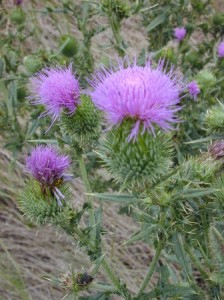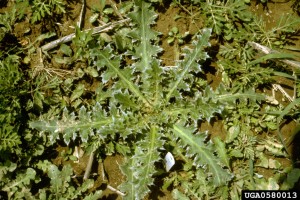 Time for Thistle Control in Pastures
Time for Thistle Control in Pastures
Libbie Johnson, UF IFAS Escambia County Extension
Most people do not scout pastures for weeds at this time of year, but this is prime time for thistles to start growing. The good news is the earlier you identify this weed and treat it, the better your control will be.
There are at least nine different species of thistle in Florida (tall thistle, Lecontes thistle, swamp thistle, Nutalls thistle, purple or yellow thistle, bull thistle, Virginia thistle). To identify the species you have, please see Table 1 at this link for a Taxonomic key for Thistles.
The control is the same regardless of the species. The standard UF IFAS Extension recommendation is two quarts of a 2,4-D product during rosette stage. Expect 90 percent control of the weed if 2,4-D is applied while the plant is still in the rosette stage.
For a little more money, apply GrazonNext at two pints per acre and get 99 percent control. Even if the plant has begun to bolt, GrazonNext will provide 95 percent control. To see different control options for various stages, please review this table.
All thistles mentioned above are biennials, with the exception of Lecontes thistle which is a perennial. Biennial plants are those growing from seed in one year and which produce seeds the second year.
There are three distinct life stages pertaining to management of thistle. During the first year the plant will grow as a rosette, a taproot with a cluster of leaves on or near the soil surface (see picture below). During the second year, a stalk will elongate from the rosette, which is referred to as bolting. The plant then flowers, produces seed, and dies.
The rosette growth stage occurs primarily during the winter months in Florida. Bolting occurs from late January through July, and flowering occurs from April through August.
Do not wait until the pretty purple flowers appear. Take advantage of this weather and walk your pastures looking for thistles. If you find a different winter weed and want it identified, bring it by your local Extension office or call your local Extension agent.
If you don’t know where to find us, please visit this site and see all of our contact information. For more information about thistles, please see Dr. Sellers and Dr. Ferrell’s EDIS publication, Thistle Control in Pastures.

